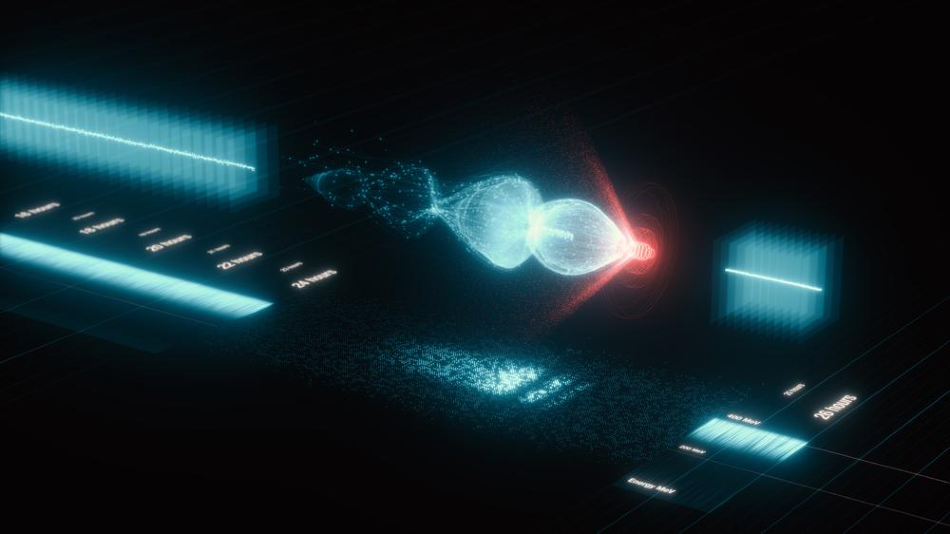Aug 20 2020
Scientists from Deutsches Elektronen-Synchrotron (DESY) have made a major breakthrough that may lead to the development of next-generation particle accelerators.
 In laser-plasma acceleration, a strong laser pulse (red) generates a plasma wave (blue) in hydrogen gas by stripping electrons from gas molecules. The electrons (red) ride the wave like a surfer in the wake of a boat. This pushes them to high energies extremely quick. The LUX facility has now continuously delivered more than 100 000 of these particle bunches in around 30 hours. Image Credit: DESY, Science Communication Lab.
In laser-plasma acceleration, a strong laser pulse (red) generates a plasma wave (blue) in hydrogen gas by stripping electrons from gas molecules. The electrons (red) ride the wave like a surfer in the wake of a boat. This pushes them to high energies extremely quick. The LUX facility has now continuously delivered more than 100 000 of these particle bunches in around 30 hours. Image Credit: DESY, Science Communication Lab.
In a first-of-its-kind study, a supposed laser-plasma accelerator has run for over a single day while constantly creating electron beams.
Mutually designed and operated by DESY and the University of Hamburg, the LUX beamline clocked a run time of 30 hours.
“This brings us a big step closer to the steady operation of this innovative particle accelerator technology,” stated Andreas R. Maier, the group leader from DESY. The team has reported this latest record in the Physical Review X journal.
The time is ripe to move laser plasma acceleration from the laboratory to practical applications.
Wim Leemans, Director, Accelerator Division, DESY
According to physicists, the laser-plasma acceleration method will result in a new generation of compact and robust particle accelerators, providing special characteristics for a host of applications.
In the laser-plasma acceleration method, an energetic particle beam or laser produces a plasma wave within a fine capillary. A plasma is a kind of gas in which electrons have been removed from gas molecules. Hydrogen is used as gas in the LUX beamline.
The laser pulses plough their way through the gas in the form of narrow discs, stripping the electrons from the hydrogen molecules and sweeping them aside like a snow plough. Electrons in the wake of the pulse are accelerated by the positively charged plasma wave in front of them—much like a wakeboarder rides the wave behind the stern of a boat.
Andreas R. Maier, Team Lead, Centre for Free-Electron Laser Science, DESY
The Centre for Free-Electron Laser Science is a joint enterprise between DESY, the Max Planck Society, and the University of Hamburg.
Through this phenomenon, laser-plasma accelerators attain acceleration strengths that are about a thousand times higher than what could possibly be delivered by the most robust machines of today.
Plasma accelerators will lead to more robust and compact systems for a variety of applications, right from rudimentary studies to medicine. However, there are still many technical challenges that need to be resolved before such devices can be put to practical applications.
“Now that we are able to operate our beamline for extended periods of time, we will be in a better position to tackle these challenges,” Maier added.
At the time of the record-breaking nonstop operation, over 100,000 bunches of electrons were accelerated, one per second. Due to this huge dataset, the characteristics of the laser, the accelerator, and the electrons bunches can be correlated and examined much more accurately.
Unwanted variations in the electron beam can be traced back to specific points in the laser, for example, so that we now know exactly where we need to start in order to produce an even better particle beam.
Andreas R. Maier, Team Lead, Centre for Free-Electron Laser Science, DESY
“This approach lays the foundations for an active stabilisation of the beams, such as is deployed on every high performance accelerator in the world,” Leemans explained.
Maier believes that the key to success is to integrate expertise from two diverse fields—plasma acceleration and knowledge in the stable operation of the accelerator.
“Both are available at DESY, which is unparalleled in the world in this respect,” emphasized Maier.
According to Maier, various factors—from laser expertise and vacuum technology to an advanced and in-depth control system—contributed to the steady and long-term operation of the accelerators.
“In principle, the system could have kept running for even longer, but we stopped it after 30 hours,” Maier added. “Since then, we have repeated such runs three more times.”
“This work demonstrates that laser plasma accelerators can generate a reproducible and controllable output. This provides a concrete basis for developing this technology further, in order to build future accelerator-based light sources at DESY and elsewhere,” summarized Leemans.
The study also involved scientists from DESY, the University of Hamburg, the European ELI-Beamlines Project, and the Max Planck Research School for Ultrafast Imaging & Structural Dynamics (IMPRS-UFAST).
Journal Reference:
Maier, A. R., et al. (2020) Decoding Sources of Energy Variability in a Laser-Plasma Accelerator. Physical Review X. doi.org/10.1103/PhysRevX.10.031039.